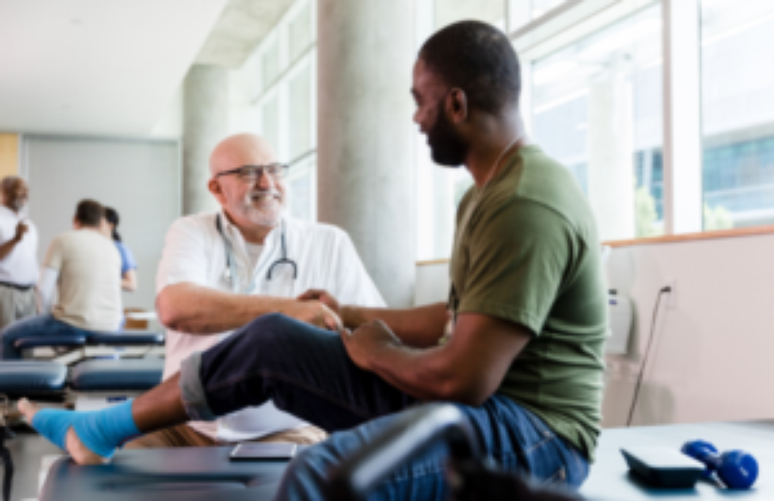Learn about tips and precautions that may be helpful in helping you recover from an orthopedic injury.
Orthopedic injuries are a type of trauma that can occur in any setting, be it in your home, crossing the street, or even from age-related wear and tear. Recovering from any injury can be difficult, even more so when it is not possible to seek adequate guidance for a specific case. That is, this injury can arise in an infinite possibility of scenarios, however, regardless of the cause, recovery from injuries of this nature is delicate and requires time and effort in treatment.
What are orthopedic injuries?
Orthopedic injuries are not directed only to the bone region. They involve the entire structure of the musculoskeletal system: bones, muscles, tendons, joints and ligaments. Therefore, some common types of orthopedic injuries can include:
- bone fractures;
- distortions;
- muscle tears;
- ligament injuries;
- disc herniations.
Proper treatment and rehabilitation play a crucial role in recovering from these injuries. However, don’t think that surgery or drug treatment alone is enough for everyone.
html[data-range=”xlarge”] figure image img.img-f6fd4d19a361d867803d0862449d2228ejslfycb { width: 774px; height: 501px; }HTML[data-range=”large”] figure image img.img-f6fd4d19a361d867803d0862449d2228ejslfycb { width: 548px; height: 354px; }HTML[data-range=”small”] figure image img.img-f6fd4d19a361d867803d0862449d2228ejslfycb, html[data-range=”medium”] figure image img.img-f6fd4d19a361d867803d0862449d2228ejslfycb { width: 564px; height: 365px; }HTML[data-range=”small”] .article__image-embed, html[data-range=”medium”] .article__image-embed { width: 564px; margin: 0 auto 30px; }
Therefore, each case faces a reality, but, in general terms, a number of precautions may be necessary.
1. Strengthen your psychological
The first step to having an effective treatment routine, pre or post-operative, is the psychological one. Maintaining a positive attitude can directly affect your recovery. The process can often be long and difficult. Focusing on the progress you’ve made and the small victories along the way can improve your mood and motivation. Every step, no matter how small, represents progress toward your recovery. It is important to remember that the recovery process is not linear. There will be times of challenges and frustrations. Additionally, emotional self-care not only promotes physical recovery but also promotes balance.
2. Respect the drug treatment
When you seek out a health professional, you will receive guidance specific to your case. Therefore, the doctor will detail the steps to follow for a successful recovery of the orthopedic injury. Within the indications, the doctor will often prescribe medications. These are crucial for managing pain, preventing infections, and promoting proper healing. It is essential that you follow the instructions to the letter and do not make any changes without consulting your professional.
3. Physiotherapy is essential
Physical therapy plays a crucial role in restoring mobility and function after orthopedic surgery or injury. The exercises and techniques recommended by your physical therapist should be performed as directed to ensure effective progress. Immediately after surgery, for example, the body undergoes significant changes. Muscles may have weakened, joints may have lost mobility, and tissues may be sore. The exercises prescribed by your physical therapist are custom designed to meet your individual needs. However, it is essential to understand that physical therapy requires commitment.
4. Hygiene care and dressings
Proper surgical site hygiene is essential to prevent infection. Keeping dressings clean, dry and protected is an important practice. Here are some key practices to ensure the health of the managed site:
- dressing maintenance: they play a vital role in protecting the incision or other wound where their use is needed. Prevents possible contamination;
- Watch for signs of infection: In addition to maintaining hygiene, it is essential to be aware of signs of worsening wound. Such as excessive redness, swelling, heat, persistent pain, discharge with an unpleasant smell, fever, among others;
- avoid excessive manipulation: in some cases it is important to avoid excessive touching of the affected region. Trust the recovery process and follow the instructions given by the medical team.
5. Use of tablets
Applying cold or hot compresses is an effective technique for relieving swelling and pain associated with orthopedic injuries. This therapeutic approach not only provides relief but also contributes to a more comfortable and effective recovery. Know the application of cold and hot compresses:
Cold packs
Cold packs, often in the form of ice packs, are recommended for recent injuries or situations where swelling is a problem. Applying cold reduces blood flow to the area, decreasing swelling and relieving inflammation. This can be especially helpful after strenuous activity or even at the end of the day when you tend to bloat more. Be sure to use a protective barrier, such as a thin washcloth, between the cold pack and your skin to prevent frostbite. Keep the compress on for about 15-20 minutes, then take a break of at least an hour before reapplying it.
Hot or warm compresses
Hot compresses, on the other hand, are more suitable for relaxing tense muscles and promoting blood circulation in the affected area. The application of heat helps relieve muscle stiffness and pain, making it an effective choice for chronic injuries or muscle problems. As with cold compresses, use a cloth or protective cover between the hot compress and the skin to avoid burns. Apply the compress for about 15-20 minutes, repeating the process if necessary. Do not use hot compresses on sensitive or inflamed areas, as this can make the condition worse. Always keep in mind that before applying any practice, it is necessary to consult a professional in the area.
6. Maintain medical follow-up
Maintaining regular follow-up with your doctor is a practice that not only allows you to monitor the progression of your healing, but also provides you with the opportunity to make adjustments to your treatment if needed. Ongoing collaboration with a healthcare professional is essential to ensure you are on the right track towards your full recovery. It is the specialist who knows the details of your condition, the goals of treatment. Therefore, maintaining this doctor-patient partnership is a vital step in achieving the best possible outcomes in your recovery. Haste is not allied with perfection. So don’t think that recovery from injury is a race. It can be a long process, but you shouldn’t push it beyond what is possible, as this rush can lead to further injuries. Respect your time and seek out qualified professionals.
Source: Terra
Ben Stock is a lifestyle journalist and author at Gossipify. He writes about topics such as health, wellness, travel, food and home decor. He provides practical advice and inspiration to improve well-being, keeps readers up to date with latest lifestyle news and trends, known for his engaging writing style, in-depth analysis and unique perspectives.









